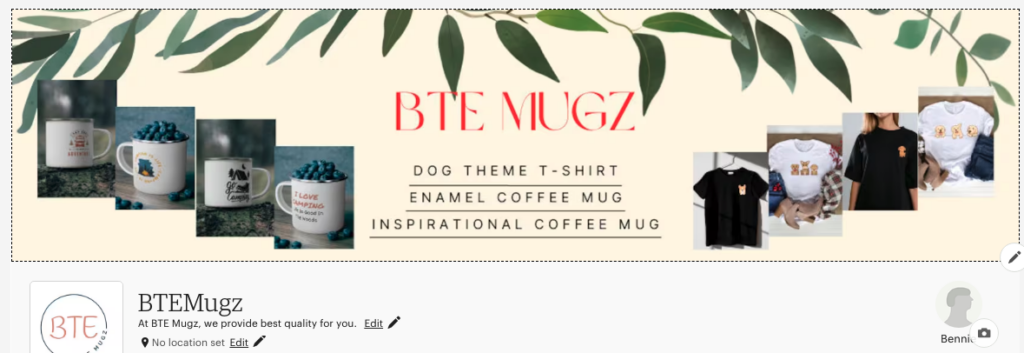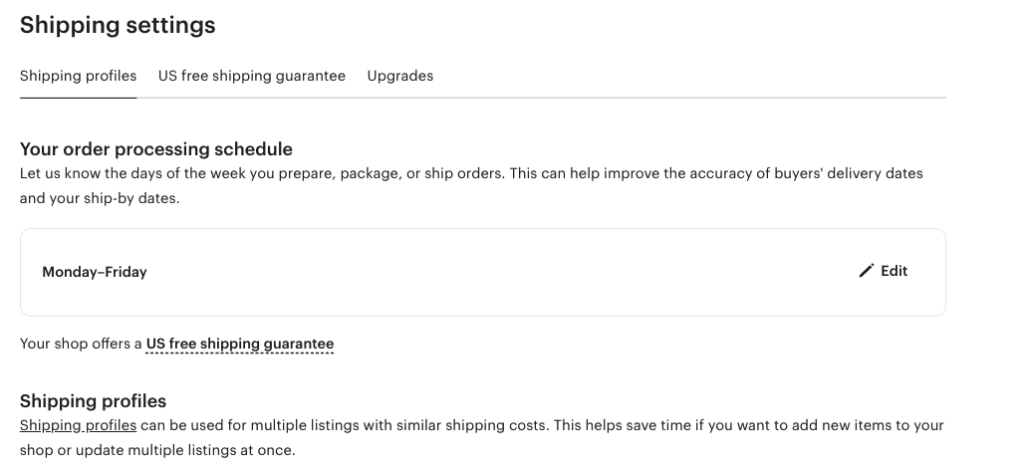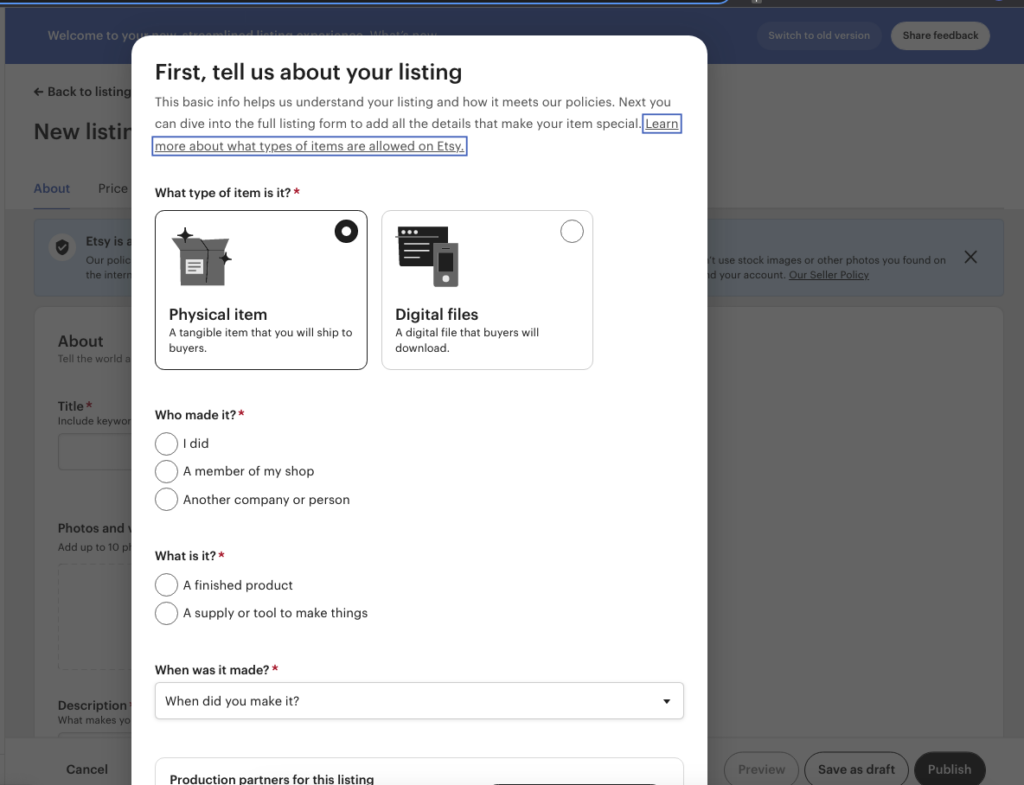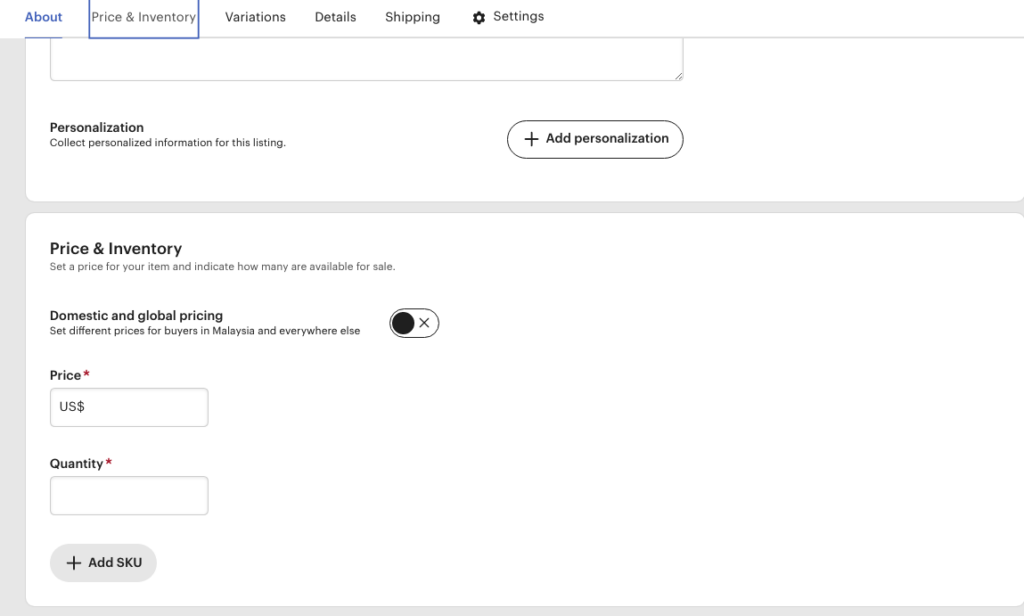Etsy is a thriving online marketplace where creative individuals and artisans can showcase and sell their unique products. If you’re a craftsperson, artist, or have a passion for creating one-of-a-kind items, Etsy is an excellent platform to turn your hobby into a business. Let’s see how you can start and sell on Etsy.
However, getting started can be intimidating, especially if you’re new to online selling. In this comprehensive guide, we’ll walk you through the process of posting on Etsy step by step.
Whether you’re a seasoned seller looking for a refresher or a beginner eager to get started, this guide will help you navigate the ins and outs of listing your products effectively on Etsy.
Start Your Print-on-Demand Business with Etsy
Step 1: Getting Started and Sell on Etsy

Signing up for an Etsy Account – Sell on Etsy
Before you can start selling on Etsy, you need to create an Etsy seller account. Here’s how:
- First, visit Etsy’s website: Go to www.etsy.com.
- Then, sign up for an Etsy Seller Account. Click on the “Sell on Etsy” option located at the top right corner of the homepage.
- Then, Fill out the registration form: Provide the required information, including your email address, password, and shop name. Your shop name should be unique and reflect your brand.
- Later, choose your shop preferences: Select your preferred language, country, and currency.
- Then, agree to Etsy’s terms: Carefully read and accept Etsy’s terms of use and seller policy.
- Finally, open your Etsy shop: Once your account is created, you can open your Etsy shop. Follow the prompts to set up your shop, including choosing your shop’s payment and shipping options.

Start Your Print-on-Demand Business with Etsy
Step 2: Planning Your Etsy Shop – Sell on Etsy
Finding Your Niche
You should always start by considering what you’re passionate about creating. Whether it’s handcrafted jewellery, vintage clothing, personalised artwork, or any other product, your enthusiasm for your craft will shine through in your work and attract like-minded customers.
In the end, you are going to work long hours in the business. It will be very hard to continue if you are not interested or passionate about it.
While passion is crucial, it’s essential to ensure there is a demand for your chosen niche. You can use tools like Google Trends, Etsy’s search bar, or third-party market research tools to assess the popularity of your niche.
Also, look for trends and seasonality that may affect sales.
Finally, you need to know who you want to serve. You need to know who is your audience and who are your ideal customers. Overall, the more details you know about them better you can create the products that they want.
You can consider factors like age, gender, interests, and location. And then. tailoring your products and marketing efforts to your target audience can increase your shop’s appeal.
Researching the Competition to Sell on Etsy

Your competitors are your good teachers too. You can first, look at the top-selling shops within your niche. In addition, you can also study their product listings, pricing strategies, and customer reviews.
Take note of what seems to be working for them, but also look for gaps in their offerings that you can fill. You can create a swipe file of successful products and stores. And when you are creating your product, you can always refer to the swipe file.
Then, assess the price ranges of similar products. Are they high-end, mid-range, or budget-friendly? You need to determine where your products fit in and price them accordingly.
Be competitive enough to make sales, but at the same time ensure your prices cover production costs, marketing and platform costs and allow for a reasonable profit margin.
Finally, you need to give a reason for people to buy from you. This means you need to identify what makes your products unique. For example, it could be your design style, quality, customization options, or the story behind your creations.
Highlight your unique selling proposition in your product descriptions and shop branding. This will give people the push to buy from you.
Setting Your Pricing Strategy
When you are pricing your product, you need to know all the costs involved. Then, calculate the total cost to make sure your pricing covers all the costs. Some basic costs include the production cost of your products, labour cost, overhead, platform cost, marketing fees and Etsy fees.
This will be your overall product cost. From there, you will need to add the margin you want. When you have your price in place, look at how much other competitors are selling that. Then, make sure your price is at a healthy rank. Not too high or too low from the average.
If you have your brand name established or you have some unique selling proposition in your products that your customers can’t find elsewhere, you can increase your price as well.
Perceived value is where you can charge more for the same products. Else, you can also think about a bundle offer where they can buy more different products from you and get some freebies from the purchase.
You can offer digital downloads as freebies as that will not increase your cost much. However, your customers will appreciate the freebies if they can bring value to them. This is how you can justify a higher price.
Start Your Print-on-Demand Business with Etsy
Step 3: Creating and Gathering Your Product Listings – Sell on Etsy

Product Photography
Your product image is the most important in your product page. Your customers will not touch your products. Product photography is the only way they know your product and decide to buy.
So, if possible, invest in a good camera or smartphone with a high-quality camera. Adequate lighting is crucial, so consider purchasing or creating a well-lit space for your product photography.
After getting the right equipment, you need to have a good background and place for your product photo. You don’t want a messy background for your product photo.
Instead, use a clean, clutter-free background that complements your product’s style. Neutral colours or textured surfaces work well. Avoid distracting backgrounds that take the focus away from your product.

When taking your product photo, you need to capture it from multiple angles. This will give customers a comprehensive view of the products from different angles. Finally, show close-ups of intricate details and any unique features.
Another type of product photo will be a lifestyle photo. You want to show them how the product looks in real life. When they can imagine using that product, it will be more relatable to them.
Finally, make sure to edit your photos to enhance brightness, contrast, and sharpness. There are various photo editing tools and apps available to help you achieve professional-looking images.
Writing Compelling Product Descriptions
Your product descriptions should provide all essential information while being engaging and compelling. Describe the item’s size, colour options, materials, and any customization choices.
In addition, you should highlight the key features and benefits of your product. Explain how it can solve a problem or enhance the buyer’s life. People don’t buy because of the specs of the product. They are buying it to solve a problem for them.
For them to resonate with the product, share the story behind the product, if applicable. This could include your creative process, inspiration, or the uniqueness of the materials used.
If possible, create a FAQ in your product description so your customer’s questions can be answered without them reaching out to your customer support.
Your product descriptions shall be easy to read as people used to scan through your product descriptions. To do this, you can use bullet points and clear headings to make the information easy to scan. In addition, a well-organized description is more likely to be read thoroughly.
Finally, your product visibility for Etsy relies much on Etsy SEO. Do good research for the relevant keywords and incorporate relevant keywords naturally into your descriptions to improve search visibility.
Start Your Print-on-Demand Business with Etsy
Step 4: Setting Up Your Etsy Shop – Sell on Etsy

Branding is what differentiates your shop from others. You need to create unique branding for your shop. However, for Etsy, you are not able to design your store and product page yourself.
However, there are a few things that you can change for your store branding.
Shop Name and Banner
Your shop name should be unique, memorable, and reflective of your brand. You need to avoid overly complex or lengthy names that may be difficult for customers to remember or type. You can change your shop name later, but it’s best to select one that you plan to keep long-term.

Your shop banner is the visual introduction to your store. It’s the first thing visitors see when they land on your shop’s homepage. Create a banner that represents your brand’s style, showcases your products, and sets the tone for the shopping experience.
Shop Policies
Shop policies are what protect you from disputes and legal issues.

You need to clearly outline your shipping policies, including estimated delivery times, shipping carriers used, and any additional services (e.g., tracking, insurance) you offer. There is a benefit here to being transparent about shipping costs, especially for international customers.
When you set the right shipping time expectations for the orders, your customers will not complain when they wait for a few days for the product to arrive.
It is normal to have returns and refunds for your business. This is even a requirement for selling in some countries. You need to specify your return and refund policies. Then, indicate whether you accept returns, under what conditions, and who bears the return shipping costs. Having clear policies reduces misunderstandings and disputes.
If you offer custom or personalized orders, explain the process, including how customers can request custom items and any additional costs or timeframes involved. Most importantly, you are not going to accept refunds or returns for customized orders if your customer changes their mind.
To collect your payment, you should provide different payment options. In your shop, provide the details of the payment methods you accept, such as credit cards, Etsy Payments, PayPal, etc.
Payment and Shipping
Etsy offers various payment options for sellers. Etsy Payments is a popular choice, allowing buyers to pay with credit and debit cards, PayPal, and other methods. Ensure your payment methods align with your target customer’s preferences.

Choose your shipping options, including domestic and international shipping. Consider offering free shipping or flat-rate shipping if it makes sense for your products. Calculate shipping costs accurately to avoid undercharging.

Specify your processing times, which indicate how long it takes to prepare an order for shipping. Be realistic and transparent about these times to manage customer expectations.
Etsy offers a convenient feature for purchasing shipping labels directly through the platform. This can save you time and potentially reduce shipping costs.
Shop Announcement

Your shop announcement is a dynamic section where you can share important information, promotions, updates, and announcements with visitors. Keep this section fresh and engaging to capture potential buyers’ attention.
You should use this space well to promote any upcoming events, sales, or product launches. It’s a great way to build anticipation and generate interest.
Consider incorporating relevant keywords into your shop announcement to improve its search visibility. However, ensure that it still reads naturally and engages visitors.
Start Your Print-on-Demand Business with Etsy
Step 5: How to Post New Listings on Etsy – Sell on Etsy

Adding a New Listing

- First, Log in to your Etsy seller account if you’re not already signed in.
- Then, from your seller dashboard, click on “Shop Manager.”
- Next, under the Shop Manager menu, choose “Listings.”
- Finally, to create a new listing, click the “Add a listing” button.

Uploading Photos
- High-Quality Images: Prioritize high-quality product images. Ensure that your photos are well-lit and sharp, and showcase your products accurately.
- Multiple Angles: Capture your product from different angles to give potential buyers a comprehensive view.
- Editing: Use photo editing tools to enhance your images, adjusting brightness, contrast, and colour if necessary. Make sure your product’s colours are accurately represented.
- Lifestyle Shots: Include lifestyle shots if applicable. Show how your product can be used or worn in real-life scenarios.

Writing Titles and Descriptions
- Keyword Research: Research relevant keywords using Etsy’s search bar, Google Keyword Planner, or third-party keyword research tools. Then, incorporate these keywords naturally into your titles and descriptions.
- Engaging Titles: Craft engaging product titles that are concise and informative. You need to include key features and benefits. In addition, don’t forget to mention any unique selling points.
- Descriptive Descriptions: Write detailed and descriptive product descriptions that address potential buyer questions. Explain size, colour options, materials used, and any customization choices.
- Storytelling: If applicable, share the story behind your product, your creative process, or what makes it unique. Personal touches can create a connection with buyers.
- Formatting: Use formatting tools like bullet points and clear headings to make your description easy to read and scan.
- SEO Optimization: Optimize your listings for search by including relevant tags, attributes, and categories. Etsy’s search algorithm uses these to match your listings with potential buyers.
Setting Prices and Inventory

If your product comes in different sizes, colours, or styles, use Etsy’s variation feature to offer these options within a single listing. This simplifies the shopping experience for buyers.
Then in the inventory management section, you need to update your listing’s inventory regularly to ensure that you will have enough stock to fulfil the order. Etsy provides tools to help you keep track of available quantities. This is important because if you are offering custom or made-to-order items, a longer lead time is required to restock them.
Finally on the listing renewal. All new Etsy listings will have a four-month active duration. After this period, you can then choose to renew them for a small fee of 20 cents.
So, make sure you keep track of listing expiration dates to ensure your products remain visible.
By setting up your Etsy shop effectively and mastering the art of posting listings, you’ll be well-prepared to showcase your products to potential buyers and start building a successful online business on the platform.
Start Your Print-on-Demand Business with Etsy
Step 6: Optimizing Your Etsy Listings – Sell on Etsy

Etsy SEO is how you get visibility for your product listings on Etsy. You need to optimize your product listings based on Etsy’s search algorithm to show it up on the first page of the search result. When you are ranked, you will be getting traffic to your site.
Understanding Etsy’s Search Algorithm
Etsy uses a complex search algorithm to determine which listings appear at the top of search results. It takes into account factors like relevancy, listing quality, and customer behaviour. Therefore, understanding how this algorithm works is crucial for improving your listings’ visibility.
Keyword Research
Keyword research is an ongoing process. You need to then explore popular and trending keywords in your niche regularly. You need to look for long-tail keywords (more specific phrases) that potential buyers might use to find your products.
Using Relevant Tags and Attributes
Etsy allows you to add tags and attributes to your listings. Tags are descriptive keywords, while attributes provide specific details about your product (e.g., size, colour). Use these fields strategically to match your listings with search queries.
Monitoring and Adjusting
Use Etsy’s analytics tools to track how your listings are performing. Pay attention to which keywords and tags are driving traffic and sales. Adjust your listings based on this data to optimize your strategy.
Start Your Print-on-Demand Business with Etsy
Step 7: Managing Your Etsy Shop – Sell on Etsy

Inventory Management
Regularly update your inventory to avoid overselling and stockouts. Etsy provides tools to help you keep track of your product quantities.
Customer Communication
Respond to customer inquiries and messages promptly and professionally. Good communication can lead to positive reviews and repeat business.
Order Processing
When you receive orders, process them promptly. Package your products carefully to ensure they arrive in excellent condition. Consider adding a personal touch, like a thank-you note, to enhance the customer experience.
Handling Feedback and Reviews
Encourage buyers to leave reviews after their purchase. Positive reviews build trust and credibility. Address any negative feedback professionally and seek solutions to improve customer satisfaction.
Start Your Print-on-Demand Business with Etsy
Step 8: Promoting Your Etsy Shop – Sell on Etsy

Social Media Marketing
Promote your Etsy shop on social media platforms like Instagram, Facebook, and Pinterest. Share high-quality images of your products, engage with your audience, and run targeted ads if your budget allows.
Etsy Advertising
Etsy offers paid advertising options to boost your listings’ visibility. You can set a daily budget and choose the listings you want to promote. Monitor your ad performance and adjust your strategy accordingly.
Collaborations and Partnerships
Consider collaborating with influencers or complementary Etsy shops to expand your reach. Partnerships can introduce your products to new audiences.
Customer Engagement
Engage with your customers through email newsletters, updates, and promotions. Building a loyal customer base can lead to repeat business and referrals.
Start Your Print-on-Demand Business with Etsy
Step 9. Etsy Seller Tools – Sell on Etsy
Etsy Seller App
The Etsy Seller App allows you to manage your shop on the go. You can update listings, respond to messages, and track your sales and statistics from your mobile device.
Etsy Analytics
Use Etsy Analytics to gain insights into your shop’s performance. Track traffic, conversion rates, and customer behaviour to make informed decisions.
Etsy Seller Handbook
The Etsy Seller Handbook is a valuable resource that provides tips, tutorials, and best practices for running a successful Etsy shop. It covers a wide range of topics, from marketing to photography.
Etsy Community
Join Etsy’s seller community to connect with other shop owners, seek advice, and share your experiences. The community is a valuable source of support and knowledge.
Start Your Print-on-Demand Business with Etsy
Step 10: Tips for Success To Sell on Etsy
Staying Consistent: Consistency is not only important in product quality and branding but also in your listing schedule. Regularly add new listings to keep your shop fresh and attract returning customers.
Adapting to Market Trends: Keep a close eye on market trends, both within your niche and on Etsy as a whole. Be prepared to pivot your product offerings or marketing strategies to align with shifting consumer preferences.
Providing Excellent Customer Service: Exceptional customer service is a cornerstone of success on Etsy. In addition, you need to respond to inquiries promptly, address concerns professionally, and strive to exceed customer expectations. In the end, happy customers are more likely to leave positive reviews and recommend your shop to others.
Seeking Feedback and Continuous Improvement: Actively seek feedback from customers, both in reviews and direct communication. Use this feedback to make improvements to your products, customer service, and overall shopping experience. Be open to constructive criticism and learn from it.
Networking and Collaboration: Explore networking opportunities within the Etsy seller community. Then, connect with other shop owners, participate in forums, and attend virtual or in-person Etsy events. Collaborating with other sellers can also help expand your reach.
Scaling Your Business: As your Etsy shop grows, evaluate the potential for scaling your business. This might involve hiring help, expanding your product line, or exploring additional sales channels.
Measuring Success: Set measurable goals for your Etsy shop, such as monthly sales targets or achieving a certain number of positive reviews. Regularly assess your progress and adjust your strategies to reach your objectives.
Start Your Print-on-Demand Business with Etsy
Final Thoughts: How To Post and Sell on Etsy
Posting on Etsy is just the beginning of your journey as a successful seller on the platform. By following this step-by-step guide, you’ll be well-equipped to navigate the process of creating listings, optimizing your shop, and promoting your products effectively.
Remember that Etsy rewards dedication and creativity, so stay true to your brand, keep learning, and enjoy the exciting world of online entrepreneurship on Etsy. With hard work and perseverance, your Etsy shop can become a thriving business that showcases your passion and creativity to the world. Happy selling!





